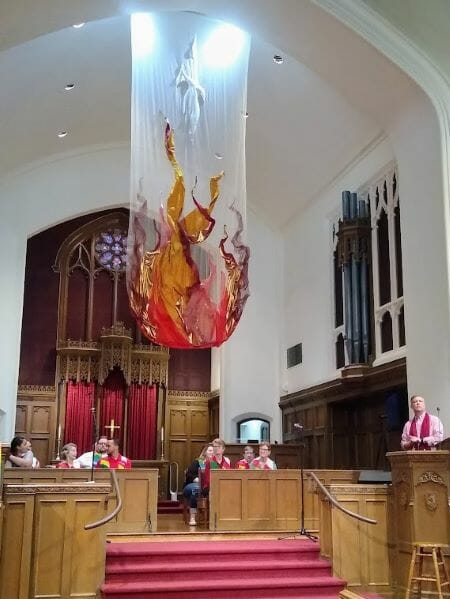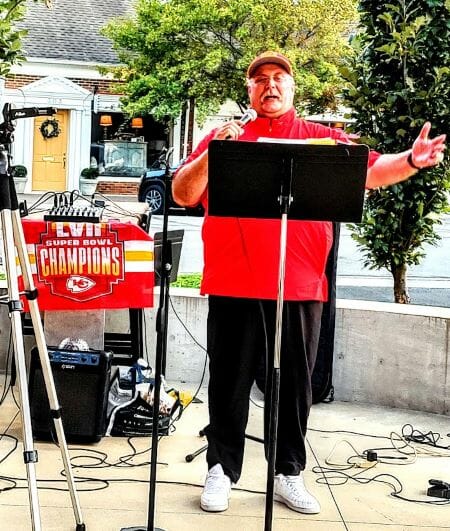Putting Your Faith in the Arts 'It was Art! It was always Art.'
Published September 24th, 2023 at 6:00 AM
Above image credit: Kansas City artist Tom Dolphens has icons and other works of art displayed in several Kansas City locations. These three icons had been in his home studio but now have been sold to a new owner. (Bill Tammeus | Flatland)At the end of the late Stanley Elkin’s biting little novel, “The Living End,” God calls together everyone hanging around in the afterlife.
They’ve been demanding an explanation of life’s mysteries — how to put a square peg in a round hole, who shot John F. Kennedy, why people drive on a parkway but park on a driveway, everything. But mostly they wanted to understand what life was supposed to be about.
Elkin’s disappointed deity eventually gets to the point: “Why did I do it (create the world) then? Why?”
Audience members make guesses, all wrong.
“No,” God thunders. “It was Art! It was always Art. It works by the contrasts and metrics, by beats and the silences. It was all Art. Because it makes a better story is why.”
But, God adds with a seismic sigh, “I never found my audience.”
The divine heartbreak is, well, heartbreaking.
Because of that failure to find an audience, Elkin has God erase them all and, with them, the cosmos. It’s not clear whether, like God in the Noah flood story, Elkin’s god will allow a new beginning.

What is clear is that religion makes precious little sense without art — without the contrasts and metrics, the beats and silences. These two lines of a modern hymn by Shirley Erena Murray, “For the Music of Creation,” celebrate Elkin’s idea of God as artist: “God, our God, the world’s composer,/ hear us, echoes of your voice —/ music is your art, your glory,/ let the human heart rejoice!”
Of course, it’s also true that from time to time, some misguided people in some branches of religion have tried to banish art as idolatrous. Thus, the Iconoclastic Controversy in the 8th and 9th centuries in Europe.
Still, the centrality of art in religion is why there are choirs, pipe organs, stained-glass windows, iconography, hymns and regular musical performances in sacred spaces. It’s why there are annual festivals such as “Art on Oak,” a two-day art fair that my congregation presents for the community each October (this year Oct. 6-7).
It’s also why each spring, summer and early fall my congregation offers free evening musical concerts by local musicians in lots of styles on our church’s front porch.
And it’s why so many other faith communities also pay attention to and honor the arts — music, architecture, carvings and paintings and encourage children to explore their own artistic talents. Indeed, art and religion together now constitute what’s called a discrete field of multidisciplinary study. And it’s hard to find better local coverage of all these arts than in KC Studio magazine.
A primary reason art is so vital to religion is that it can help keep religious leaders from becoming too attached to simplistic, literalistic answers that stymie creative thinking about the wildly free God of creation — Elkin’s divine artist. The Michelangelos, da Vincis and Caravaggios of the world (I’m showing my ignorance of art that’s not rooted in Europe and Christianity) interpret the gift of the world in unique ways and encourage followers of various faith traditions to widen their vision. Let a thousand interpretations bloom.
That’s why I sometimes think of the Nelson-Atkins Museum of Art (which always has many pieces of religious art on display), the Kemper Museum of Contemporary Art and the Kansas City Art Institute as being faith-based. (In fact, a United Church of Christ pastor, Chase Peeples, teaches an Art Institute class on world religions and a retired United Methodist pastor, Anton Jacobs, teaches various religion classes there.)
As 20th century theologian Paul Tillich argued in his book “Theology of Culture”, no artist can “escape religion even if he rejects religion, for religion is the state of being ultimately concerned.” And, he adds, that eternal concern is found in every style of art.
In some ways, I regret that my only artistic skill is sculpting words. Painting and other hands-on forms of art are beyond me. My wife Marcia is an artist and I admire her many talents. In addition, one of our grandchildren has just entered a university arts program while another is starting college to become a musical artist. And my oldest sister got her pipe organ degree from the Juilliard School.

By contrast, my art is simply this: I draw conclusions.
Still, generative religion affirms that we’re all artists, capable of somehow mediating to others the staggering loveliness of creation.
Kansas City’s Westport Center for the Arts, rooted in Westport Presbyterian Church, keeps on its website some thoughts about how art enhances the gift of life. Here’s one from the late author Toni Morrison. It’s called “Art in a Time of Chaos,” and it encompasses my point:
“This is precisely the time when artists go to work. There is no time for despair, no place for self-pity, no need for silence, no room for fear. We speak, we write, we do language. That is how civilizations heal. I know the world is bruised and bleeding, and though it is important not to ignore its pain, it is also critical to refuse to succumb to its malevolence. Like failure, chaos contains information that can lead to knowledge — even wisdom. Like art.”
I asked my friend Marian Thomas, a longtime Kansas City church organist and pianist, why she thinks art is so crucial to religion. As usual, she nailed it:
“Art opens us to the divine that lives, sometimes unrecognized, within each of us. Listening to music or spoken poetry, watching a play or ballet, observing a painting or sculpture for long enough to let it move us reminds us that, as Pierre Teilhard de Chardin wrote, ‘We are not human beings having a spiritual experience. We are spiritual beings having a human experience.’ The colors, shapes and sounds of the natural world remind us that creation is the divine at work and at play. Our lives are enriched if our religious rituals and practices involve us as co-creators with the divine.”
(Marian once gave a sermon at St. Paul School of Theology, where she worked for 15 years, and had someone dance her words as she spoke them. I’m so sorry I missed that.)
In many ways, art is the language of faith. If we don’t get that, we miss the heart of faith, with its contrasts and metrics, its beats and silences. And, at its center, its truths.
Bill Tammeus, an award-winning columnist formerly with The Kansas City Star, writes the “Faith Matters” blog for The Star’s website, book reviews for The National Catholic Reporter and for The Presbyterian Outlook. His latest book is “Love, Loss and Endurance: A 9/11 Story of Resilience and Hope in an Age of Anxiety.” Email him at wtammeus@gmail.com.


